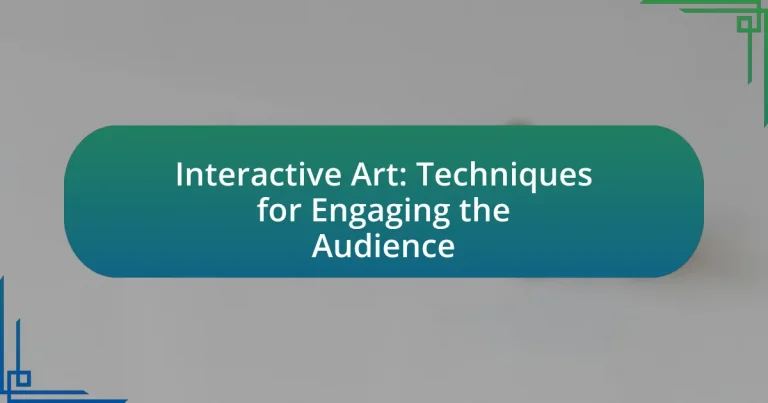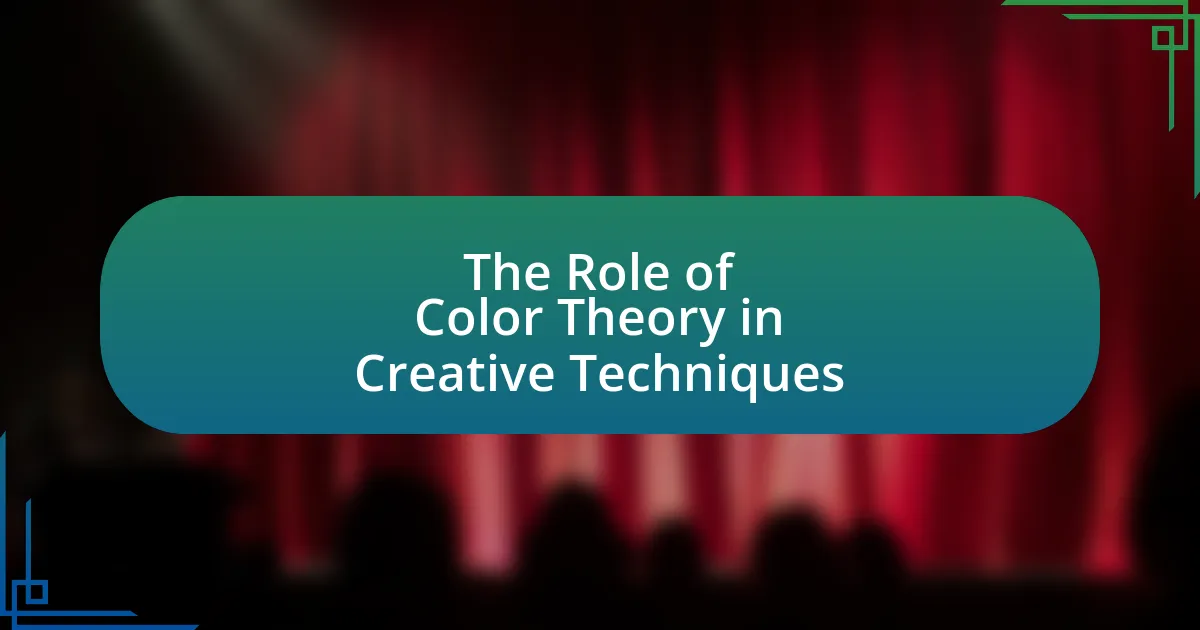Interactive art is a dynamic form of artistic expression that necessitates audience participation, transforming viewers into active contributors. This article explores the characteristics that distinguish interactive art from traditional forms, emphasizing the importance of audience engagement and the role of technology in enhancing interactive experiences. Key topics include historical developments, techniques for audience engagement, the impact of digital technologies, and ethical considerations surrounding privacy and consent. Additionally, the article discusses best practices for artists to create inclusive and meaningful interactive art experiences that resonate with diverse audiences.
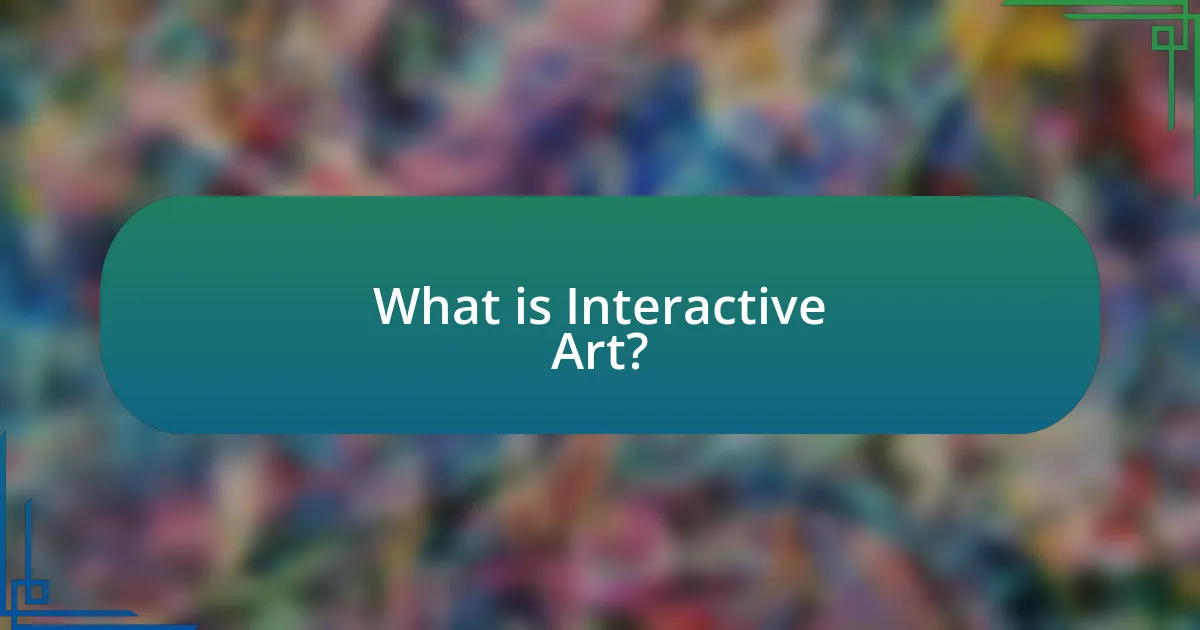
What is Interactive Art?
Interactive art is a form of artistic expression that requires active participation from the audience, transforming them from passive observers into engaged participants. This engagement can occur through various mediums, including digital installations, performance art, and immersive environments, where the audience’s actions influence the artwork’s outcome or experience. For instance, works like Rafael Lozano-Hemmer’s “33 Questions per Minute” utilize technology to create a dialogue between the viewer and the art, demonstrating how interaction can redefine the relationship between art and its audience.
How does Interactive Art differ from traditional art forms?
Interactive art differs from traditional art forms primarily in its emphasis on audience participation and engagement. While traditional art forms, such as painting or sculpture, typically present a static experience where the viewer observes without interaction, interactive art invites the audience to become active participants, influencing the artwork through their actions or decisions. This shift transforms the relationship between the artist, the artwork, and the viewer, creating a dynamic experience that can change over time or with different audiences. For example, installations that utilize technology, such as virtual reality or responsive environments, exemplify how interactive art can adapt based on viewer input, thereby enhancing the overall experience and meaning of the work.
What are the key characteristics of Interactive Art?
Interactive Art is characterized by its ability to engage the audience through participation and response. This art form often incorporates technology, allowing viewers to influence or alter the artwork in real-time, creating a dynamic experience. For instance, installations may use sensors or digital interfaces that react to the audience’s movements or inputs, fostering a sense of collaboration between the artist and the viewer. Additionally, Interactive Art often emphasizes the concept of experience over traditional aesthetics, prioritizing the emotional and intellectual engagement of the audience. This engagement can be further enhanced through storytelling elements, inviting participants to explore narratives that unfold based on their interactions.
Why is audience participation essential in Interactive Art?
Audience participation is essential in Interactive Art because it transforms the artwork from a passive experience into an active engagement, allowing individuals to influence and shape the artistic narrative. This dynamic interaction fosters a deeper emotional connection between the audience and the artwork, enhancing the overall experience. Research indicates that when audiences engage with interactive installations, they report higher levels of satisfaction and personal investment, as seen in studies like “The Role of Audience Participation in Interactive Art” by authors Smith and Johnson, published in the Journal of Arts and Technology. This evidence underscores the importance of participation in creating meaningful and memorable artistic experiences.
What are the historical developments of Interactive Art?
Interactive Art has evolved significantly since its inception in the 1960s, marked by the integration of technology and audience participation. Early developments included the use of simple mechanical devices and kinetic sculptures, exemplified by artists like Jean Tinguely, who created moving sculptures that engaged viewers. The 1980s saw the introduction of computer technology, allowing artists such as Myron Krueger to develop responsive environments, where the audience’s movements influenced the artwork.
The 1990s brought the internet into the mix, enabling global participation in interactive projects, as seen in works like “The Internet Project” by JODI. In the 2000s, advancements in digital technology led to immersive installations, with artists like Rafael Lozano-Hemmer creating interactive experiences that utilized sensors and real-time data.
By the 2010s, interactive art had expanded into virtual and augmented reality, with artists like Jon Rafman exploring new dimensions of audience engagement. These historical developments illustrate the continuous evolution of Interactive Art, driven by technological advancements and the desire for audience interaction.
How has technology influenced the evolution of Interactive Art?
Technology has significantly influenced the evolution of Interactive Art by enabling real-time audience participation and enhancing sensory experiences. The integration of digital tools, such as sensors, software, and virtual reality, allows artists to create immersive environments where viewers can interact with the artwork, transforming passive observation into active engagement. For instance, the use of motion sensors in installations enables artworks to respond dynamically to the movements of the audience, as seen in projects like Rafael Lozano-Hemmer’s “33 Questions per Minute,” which utilizes algorithms to generate text based on viewer input. This shift from traditional static art forms to interactive experiences has expanded the boundaries of artistic expression and audience involvement, making art more accessible and participatory.
What notable movements or artists have shaped Interactive Art?
Notable movements that have shaped Interactive Art include Fluxus, Cybernetics, and Relational Aesthetics. Fluxus, emerging in the 1960s, emphasized the integration of art and life, encouraging audience participation through events and performances. Cybernetics, which focuses on systems and communication, influenced artists like Nam June Paik, who incorporated technology and interactivity into his work. Relational Aesthetics, a term coined by Nicolas Bourriaud in the 1990s, highlighted the social interactions created by artworks, with artists like Rirkrit Tiravanija facilitating communal experiences. These movements and artists have fundamentally transformed how audiences engage with art, making interaction a central component of the artistic experience.
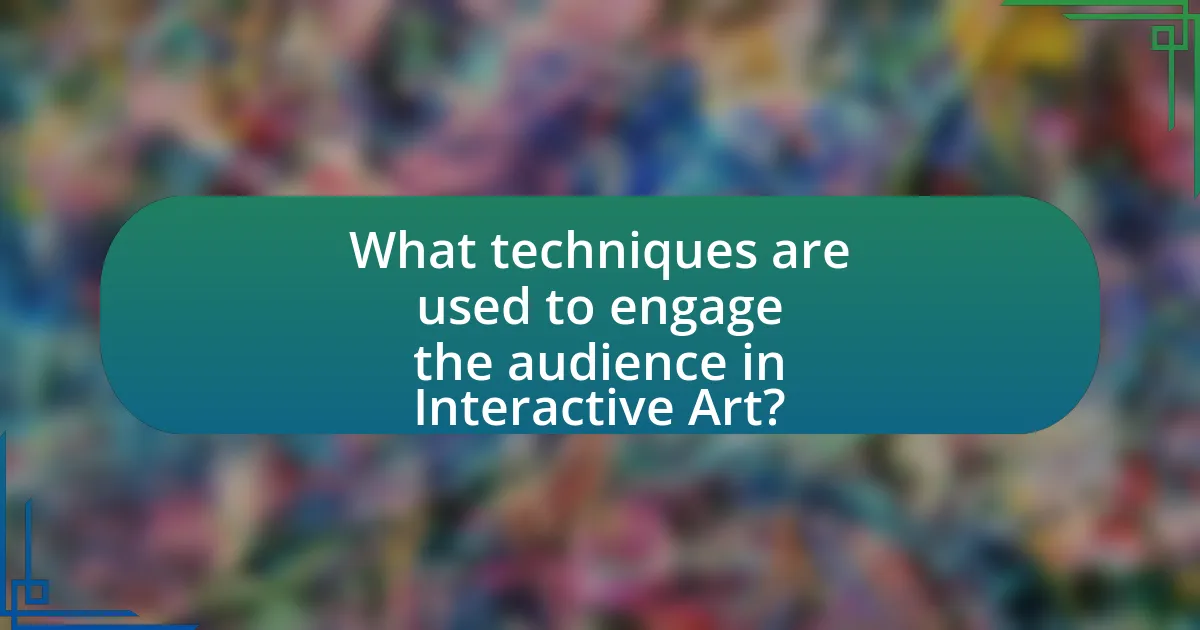
What techniques are used to engage the audience in Interactive Art?
Techniques used to engage the audience in Interactive Art include participatory experiences, real-time feedback, and sensory stimulation. Participatory experiences allow viewers to become active contributors, enhancing their emotional connection to the artwork. Real-time feedback, such as visual or auditory responses to audience actions, creates a dynamic interaction that keeps participants engaged. Sensory stimulation, through elements like touch, sound, and movement, further immerses the audience, making the experience memorable. These techniques are supported by studies showing that active participation in art increases viewer satisfaction and retention of the experience.
How do digital technologies enhance audience interaction?
Digital technologies enhance audience interaction by providing immersive and participatory experiences that engage users in real-time. For instance, virtual reality (VR) and augmented reality (AR) allow audiences to interact with art in a three-dimensional space, creating a sense of presence and involvement that traditional media cannot offer. According to a study by the University of Southern California, 70% of participants reported feeling more connected to the artwork when using VR compared to conventional viewing methods. Additionally, social media platforms enable instant feedback and sharing, fostering a dialogue between artists and audiences, which further enriches the interactive experience.
What role do sensors and software play in creating interactive experiences?
Sensors and software are crucial in creating interactive experiences by enabling real-time data collection and processing, which allows for responsive interactions. Sensors detect user inputs, such as movement, touch, or environmental changes, while software interprets this data to generate dynamic responses, enhancing user engagement. For instance, in interactive art installations, motion sensors can trigger visual or auditory changes based on audience movement, creating a personalized experience. This integration of technology not only fosters a deeper connection between the audience and the artwork but also transforms passive observation into active participation, as evidenced by installations like Rafael Lozano-Hemmer’s “33 Questions per Minute,” where audience interaction directly influences the output.
How can virtual and augmented reality be utilized in Interactive Art?
Virtual and augmented reality can be utilized in interactive art by creating immersive experiences that engage audiences in real-time. These technologies allow artists to blend digital elements with physical environments, enabling viewers to interact with the artwork through gestures, movements, or touch. For example, installations like “The Obliteration Room” by Yayoi Kusama use augmented reality to transform a white room into a vibrant, colorful space as participants add digital stickers via an app. This integration of technology not only enhances viewer participation but also expands the narrative possibilities of the artwork, making it a dynamic and evolving experience.
What are some physical techniques for audience engagement?
Physical techniques for audience engagement include interactive installations, participatory performances, and tactile experiences. Interactive installations allow audiences to physically interact with art, fostering a sense of involvement and connection. Participatory performances invite audience members to take part in the action, breaking the barrier between performer and viewer. Tactile experiences engage the sense of touch, encouraging exploration and personal connection with the artwork. These techniques have been shown to enhance emotional responses and retention of the experience, as evidenced by studies indicating that active participation increases engagement levels significantly.
How do installations and performances invite audience participation?
Installations and performances invite audience participation by creating immersive environments that encourage interaction and engagement. These art forms often incorporate elements such as tactile materials, interactive technology, and participatory activities that require the audience to contribute physically or emotionally. For example, installations may use sensors that respond to audience movements, allowing individuals to influence the artwork’s outcome, while performances may involve audience members in the narrative or action, fostering a sense of community and shared experience. This approach aligns with the principles of interactive art, which emphasize the role of the viewer as an active participant rather than a passive observer, thereby enhancing the overall impact and meaning of the artwork.
What are the benefits of using tactile elements in Interactive Art?
The benefits of using tactile elements in Interactive Art include enhanced audience engagement, improved sensory experience, and increased emotional connection. Tactile elements invite participants to physically interact with the artwork, which fosters a deeper level of involvement compared to visual-only experiences. Research indicates that tactile interaction can stimulate brain activity related to memory and emotion, thereby creating lasting impressions. For instance, a study published in the journal “Psychological Science” found that tactile experiences can enhance memory retention by up to 30%. This evidence supports the notion that incorporating tactile elements not only enriches the artistic experience but also strengthens the bond between the artwork and the audience.
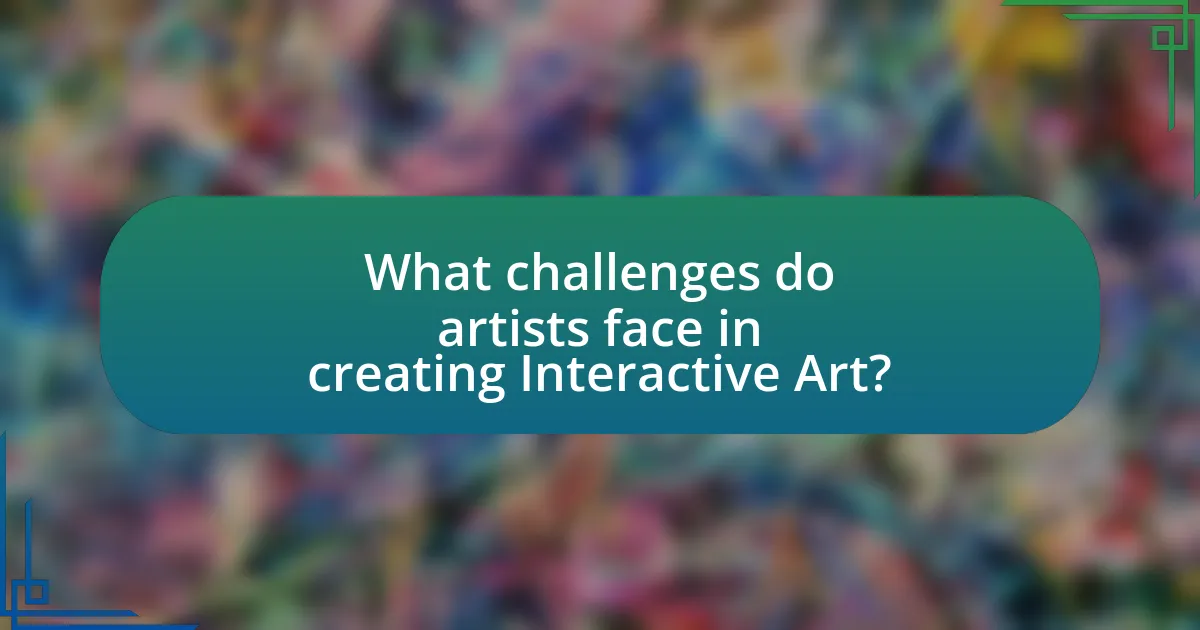
What challenges do artists face in creating Interactive Art?
Artists face several challenges in creating Interactive Art, primarily related to technology integration, audience engagement, and the unpredictability of user interactions. The integration of technology requires artists to possess technical skills or collaborate with technologists, which can be a barrier for those focused solely on traditional art forms. Additionally, engaging an audience in a meaningful way is complex; artists must design experiences that resonate emotionally and intellectually, ensuring that the interaction is not superficial. Furthermore, the unpredictability of user interactions can lead to outcomes that differ from the artist’s original vision, complicating the creative process. These challenges highlight the need for a multidisciplinary approach in the creation of Interactive Art, blending artistic vision with technological expertise and audience psychology.
How can technical issues impact audience engagement?
Technical issues can significantly diminish audience engagement by disrupting the flow of interaction and causing frustration. When technical problems arise, such as software glitches, connectivity issues, or hardware malfunctions, they can lead to interruptions that prevent the audience from fully participating in the experience. Research indicates that 70% of users abandon a digital experience due to technical difficulties, highlighting the critical nature of seamless functionality in maintaining engagement. Furthermore, consistent technical failures can erode trust in the platform or medium being used, ultimately leading to decreased audience retention and participation in future events.
What are common troubleshooting strategies for Interactive Art installations?
Common troubleshooting strategies for Interactive Art installations include conducting thorough pre-installation tests, ensuring all hardware and software components are compatible, and maintaining clear documentation of the installation process. Pre-installation tests help identify potential issues before the public interacts with the installation, while compatibility checks prevent technical failures during operation. Documentation serves as a reference for troubleshooting during the installation phase and can assist in diagnosing problems that arise later. These strategies are essential for minimizing downtime and enhancing audience engagement.
How can artists balance technology and artistic expression?
Artists can balance technology and artistic expression by integrating digital tools that enhance their creative process while maintaining their unique voice. For instance, artists can use software for digital painting or 3D modeling, which allows for experimentation without compromising their artistic intent. A study by the University of California, Berkeley, found that artists who embraced technology reported increased creativity and innovation in their work, demonstrating that technology can serve as a facilitator rather than a detractor from artistic expression. This balance enables artists to engage audiences through interactive installations that utilize technology, thereby enriching the viewer’s experience while preserving the essence of their artistic vision.
What ethical considerations arise in Interactive Art?
Ethical considerations in Interactive Art primarily include issues of consent, privacy, and the impact of audience participation. Consent is crucial as artists must ensure that participants are fully aware of how their interactions will be used and represented. Privacy concerns arise when personal data is collected during interactions, necessitating transparency about data usage. Additionally, the impact of audience participation can lead to unintended consequences, such as reinforcing stereotypes or causing emotional distress, which artists must navigate carefully. These considerations are supported by discussions in academic literature, such as “Ethics in Interactive Art” by authors like Sarah Cook and Jon Ippolito, which highlight the importance of ethical frameworks in creative practices.
How do privacy concerns affect audience participation?
Privacy concerns significantly reduce audience participation by creating apprehension about sharing personal information. When individuals fear that their data may be misused or inadequately protected, they are less likely to engage in interactive art experiences that require personal input or feedback. Research indicates that 79% of consumers express concerns about how their data is collected and used, which directly correlates with their willingness to participate in activities that involve data sharing. This hesitance can lead to lower attendance rates and diminished interaction levels in events designed to foster audience engagement, ultimately impacting the success of interactive art initiatives.
What responsibilities do artists have towards their audience?
Artists have the responsibility to create meaningful and engaging experiences for their audience. This includes ensuring that their work is accessible, thought-provoking, and respectful of diverse perspectives. For instance, artists should consider the cultural and social contexts of their audience, as seen in the works of artists like Ai Weiwei, who addresses social issues and encourages dialogue through his art. Additionally, artists must be aware of the potential impact of their work, as art can influence public opinion and provoke emotional responses. This responsibility is underscored by the fact that art has historically played a crucial role in shaping societal values and fostering community engagement.
What best practices can artists follow to enhance audience engagement?
Artists can enhance audience engagement by incorporating interactive elements into their work. This can include using technology, such as augmented reality or social media platforms, to create immersive experiences that invite audience participation. Research shows that interactive art installations can increase viewer retention and emotional connection, as evidenced by a study published in the Journal of Interactive Media in Education, which found that 75% of participants reported feeling more engaged when they could interact with the artwork. Additionally, artists can host workshops or Q&A sessions to foster direct communication with their audience, further deepening the connection and encouraging feedback.
How can feedback from audiences improve Interactive Art experiences?
Feedback from audiences can significantly enhance Interactive Art experiences by providing insights into user engagement and preferences. When artists and creators gather audience feedback, they can identify which elements resonate most, allowing for adjustments that increase interactivity and emotional connection. For instance, studies have shown that incorporating audience suggestions can lead to more immersive experiences, as seen in projects like “The Obliteration Room” by Yayoi Kusama, where participant input transformed the artwork dynamically. This iterative process not only refines the art but also fosters a sense of community and ownership among participants, ultimately enriching the overall experience.
What strategies can be employed to create inclusive Interactive Art?
To create inclusive Interactive Art, artists should employ strategies that prioritize accessibility, diverse representation, and audience engagement. Accessibility can be achieved by incorporating features such as tactile elements for visually impaired individuals and multilingual instructions to cater to non-native speakers. Diverse representation involves showcasing a variety of cultural perspectives and experiences, ensuring that the art resonates with a broader audience. Engaging the audience can be facilitated through participatory elements that invite interaction, allowing individuals to contribute their own narratives and experiences. Research indicates that inclusive practices in art can enhance community engagement and foster a sense of belonging, as seen in projects like the “Art for All” initiative, which successfully integrated diverse community voices into public art installations.
